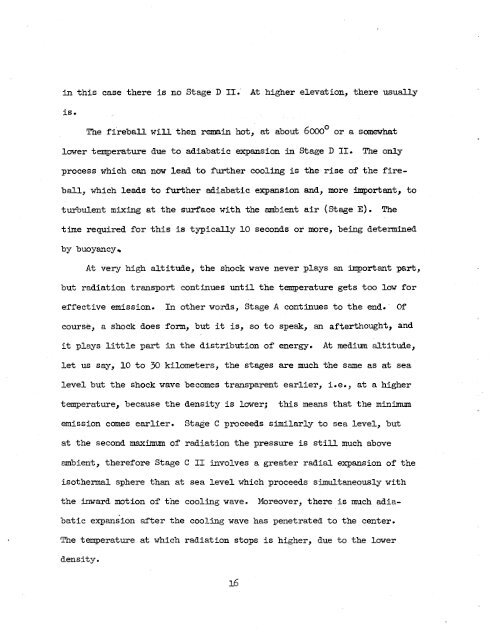Theory of the Fireball
Theory of the Fireball
Theory of the Fireball
Create successful ePaper yourself
Turn your PDF publications into a flip-book with our unique Google optimized e-Paper software.
in this case <strong>the</strong>re is no Stage D 11.. At higher elevation, <strong>the</strong>re usually<br />
is.<br />
The fireball will <strong>the</strong>n remain hot, at about 6000~ or a somewhat<br />
lower temperature due to adiabatic expansion in Stage D I1 . The only<br />
process which can now lead to fur<strong>the</strong>r cooling is <strong>the</strong> rise <strong>of</strong> <strong>the</strong> fire-<br />
ball, which leads to fur<strong>the</strong>r adiabatic expansion and, more important, to<br />
turbulent mixing at <strong>the</strong> surface with <strong>the</strong> ambient air (Stage E) . The<br />
time required for this is typically 10 seconds or more, being determined<br />
by buoyancy<br />
At very high altitude, <strong>the</strong> shock wave never plays an important part,<br />
but radiation transport continues until <strong>the</strong> temperature gets too low for<br />
effective emission. In o<strong>the</strong>r words, Stage A continues to <strong>the</strong> end.' Of<br />
course, a shock does form, but it is, so to speak, an afterthought, and<br />
it plays little part in <strong>the</strong> distribution <strong>of</strong> energy, At medium altitude,<br />
let us say, 10 to 30 kilometers, <strong>the</strong> stages are much <strong>the</strong> same as at sea<br />
level but <strong>the</strong> shock wave becomes transparent earlier, i.e., at a higher<br />
temperature, because <strong>the</strong> density is later; this means that <strong>the</strong> minimum<br />
emission comes earlier. Stage C proceeds similarly to sea level, but<br />
at <strong>the</strong> second maximum <strong>of</strong> radiation <strong>the</strong> pressure is still much above<br />
ambient, <strong>the</strong>refore Stage C I1 involves a greater radial expansion <strong>of</strong> <strong>the</strong><br />
iso<strong>the</strong>rmal sphere than at sea level which proceeds simultaneously with<br />
<strong>the</strong> inward motion <strong>of</strong> <strong>the</strong> cooling wave. Moreover, <strong>the</strong>re is much adia-<br />
16
















